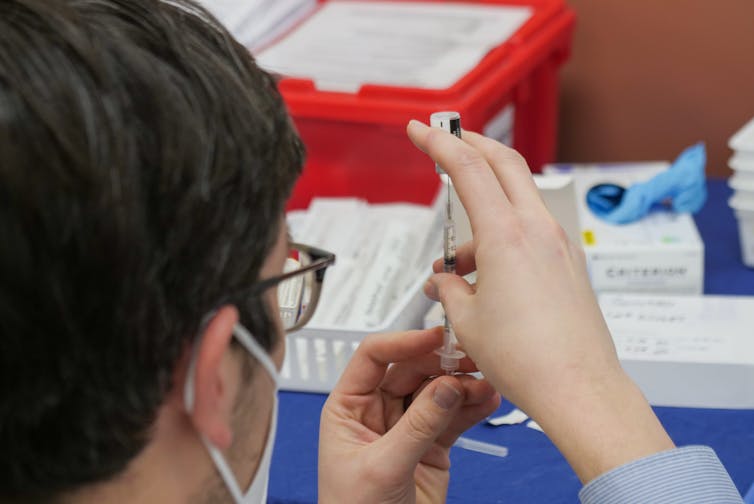Over the last year, COVID vaccination recommendations have been updated regularly. So it can be difficult to keep track of how many vaccine doses you and your family members need.
This may seem confusing, but it is actually a good approach to take when navigating a pandemic, especially when the virus keeps changing. Let’s look at the current Australian recommendations and why vaccine advice needs to evolve over time.
Why do recommendations need updating?
The nature of the COVID pandemic has changed over the past two years and will likely continue to change. The virus of today is more contagious and less deadly than the virus of 2020.
The collective immunity of the Australian population has improved, thanks to most of us getting vaccinated (95% of Austalians aged over 16 have had two doses) and a surge of infections at the start of this year.
A changing virus and rising immunity levels in the population mean the benefits and risks of vaccination also change.
The goal is to make sure we use the current vaccines in a way that offers the most benefit and least harm.
Recently ATAGI recommended the interval between primary doses (that is the first two doses) should be eight weeks and people should wait until three months after they have had natural infection before they get the next vaccine they are due. The advisory group said the extended dose interval had been shown to improve immune response to vaccination and may reduce the risk of myocarditis and pericarditis.
Preventing serious illness
ATAGI’s COVID vaccination recommendations are designed to minimise the risk of serious illness in the individual being vaccinated.
Preventing the spread of virus was of prime importance last year. We’ve since learnt serious illness is less common with the Omicron variant and the vaccines’ ability to prevent its spread is short-lived and limited.
ATAGI has now identified the prevention of serious illness and death as the principal role for vaccines at this stage of the pandemic.
Nonetheless, a substantial number of people still become seriously unwell from Omicron and require hospitalisation. Fortunately, booster doses of the COVID vaccines remain excellent at preventing severe infections.

Who needs a winter shot?
There are several groups of people for whom a “winter” booster dose is recommended – to be given from four months after the booster or third dose (whatever the season).
A person’s age is the single biggest risk factor for severe COVID disease. The presence of immunosuppression or some other chronic health conditions is important too, but age plays the most substantial role.
Risk of death and admissions to intensive care units are highest among those aged 65 and older. So the benefits of preventing serious illness with a winter dose are most clear in this age group. A study from Israel showed reduced COVID hospitalisations and deaths after a second booster (a fourth dose) in Israeli adults aged 60 years and over.
This case is strengthened because the very rare, yet serious, side effects of vaccination – like myocarditis after mRNA vaccines – are uncommon in this age group. If you are over 65, you should plan for a winter dose from four months after your booster. Accordingly, residents of aged care facilities are recommended a winter dose, as are those in disability residential care.
First Nations people aged 50 years and older and anyone aged 16 years and older who have severe immune-suppression are also recommended for a winter shot.
What about others aged 16 to 64?
For most Australians aged 16 to 64, it is not clear a fourth “winter booster” vaccination is needed.
UK data shows the primary course and booster or third dose of COVID vaccination have been effective at preventing serious disease from Omicron, however indicate that immunity from the booster dose is also likely to wane.
Read more: 16-17 year olds can now get their COVID boosters. Why not younger children?
Are kids aged 5–15 due another shot? What about under 5s?
COVID vaccination has not been recommended for babies and children under 5 years.
When it comes to children and young teenagers (who are not severely immunocompromised) we don’t have enough evidence of the extra benefit of a booster (third) dose.
What we do know is that serious illness in this age group, including those with severe immunocompromise and other medical conditions, is rare. Studies in the US, South Africa and the UK have suggested that although there may be a higher hospitalisation rate with Omicron compared to Delta infection they were less severe (less likely to need ICU, ventilation or lead to death).
We also know the risk of vaccination, principally myocarditis, is rare in children under 11 years old (but under active surveillance) and side effects are proportionally larger in teenagers.
At present, the benefits of vaccination are smaller than for adults and the majority of already-vaccinated young teenagers are not experiencing severe disease.
Read more: The Moderna vaccine is now available for 6 to 11 year olds. Here's what parents need to know
The most up-to-date advice from ATAGI is available and shown below. But as the benefit versus risk equation continues to change, expect these recommendations to change too. Remember the aim remains the same: to prevent serious illness for you and in our community.
The University of Sydney where Nicholas Wood is employed receives funding from the NHMRC for the conduct of vaccine research. He holds a Churchill Fellowship awarded in 2019.
This article was originally published on The Conversation. Read the original article.







